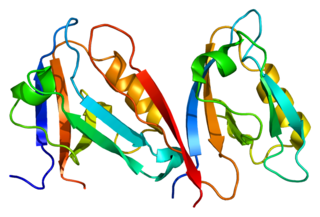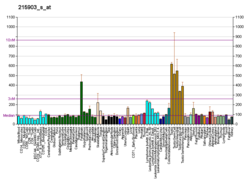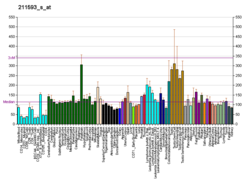
TRAF6 is a TRAF human protein.

TNF receptor-associated factor 2 is a protein that in humans is encoded by the TRAF2 gene.

Mitogen-activated protein kinase kinase kinase 7 (MAP3K7), also known as TAK1, is an enzyme that in humans is encoded by the MAP3K7 gene.

Calcium/calmodulin-dependent protein kinase type IV is an enzyme that in humans is encoded by the CAMK4 gene.

Sequestosome-1 is a protein that in humans is encoded by the SQSTM1 gene. Also known as the ubiquitin-binding protein p62, it is an autophagosome cargo protein that targets other proteins that bind to it for selective autophagy. By interacting with GATA4 and targeting it for degradation, it can inhibit GATA-4 associated senescence and senescence-associated secretory phenotype.

Interleukin-1 receptor-associated kinase 1 (IRAK-1) is an enzyme in humans encoded by the IRAK1 gene. IRAK-1 plays an important role in the regulation of the expression of inflammatory genes by immune cells, such as monocytes and macrophages, which in turn help the immune system in eliminating bacteria, viruses, and other pathogens. IRAK-1 is part of the IRAK family consisting of IRAK-1, IRAK-2, IRAK-3, and IRAK-4, and is activated by inflammatory molecules released by signaling pathways during pathogenic attack. IRAK-1 is classified as a kinase enzyme, which regulates pathways in both innate and adaptive immune systems.

Serine/threonine-protein kinase N1 is an enzyme that in humans is encoded by the PKN1 gene.

Receptor-interacting serine/threonine-protein kinase 2 is an enzyme that in humans is encoded by the RIPK2 gene.

Mitogen-activated protein kinase kinase kinase 14 also known as NF-kappa-B-inducing kinase (NIK) is an enzyme that in humans is encoded by the MAP3K14 gene.

Alpha-1-syntrophin is a protein that in humans is encoded by the SNTA1 gene. Alpha-1 syntrophin is a signal transducing adaptor protein and serves as a scaffold for various signaling molecules. Alpha-1 syntrophin contains a PDZ domain, two Pleckstrin homology domain and a 'syntrophin unique' domain.

Polo-like kinase 3 (Drosophila), also known as PLK3, is an enzyme which in humans is encoded by the PLK3 gene.

Serine/threonine-protein kinase MARK2 is an enzyme that in humans is encoded by the MARK2 gene.

Mitogen-activated protein kinase kinase kinase 7-interacting protein 2 is an enzyme that in humans is encoded by the MAP3K7IP2 gene.

Tribbles homolog 3 is a protein that in humans is encoded by the TRIB3 gene.

Caspase recruitment domain-containing protein 11 also known as CARD-containing MAGUK protein 1 is a protein in the CARD-CC protein family that in humans is encoded by the CARD11 gene. CARD 11 is a membrane associated protein that is found in various human tissues, including the thymus, spleen, liver, and peripheral blood leukocytes. Similarly, CARD 11 is also found in abundance in various lines of cancer cells.

Serine/threonine-protein kinase Nek6 is an enzyme that in humans is encoded by the NEK6 gene.

MAP/microtubule affinity-regulating kinase 3 is an enzyme that in humans is encoded by the MARK3 gene.

Serine/threonine-protein phosphatase 4 catalytic subunit is an enzyme that in humans is encoded by the PPP4C gene.

Serine/threonine-protein kinase PLK2 is an enzyme that in humans is encoded by the PLK2 gene.

MAP/microtubule affinity-regulating kinase 4 is an enzyme that in humans is encoded by the MARK4 gene. MARK4 belongs to the family of serine/threonine kinases that phosphorylate microtubule-associated proteins (MAP) causing their detachment from microtubules. Detachment thereby increases microtubule dynamics and facilitates a number of cell activities including cell division, cell cycle control, cell polarity determination, and cell shape alterations.

























